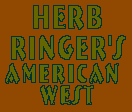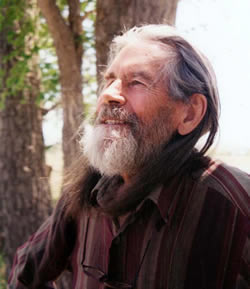 |
||||||
|
|
Vision is dangerous. The danger is that the single indiividual blessed wih a most convincing, out-of-the-routine-of-life experience, is captured, convinced, cornered. Then that solitary individual, one of billions of humans on this planet, so easily considers himself chosen by Nature or by God and thereby endowed with an extra dose of wisdom. He is superior to the ordinary run of humanity. The temptation to become a savior is hard to resist. The chosen one preaches the vision, forcing it on others, builds a church on it, John Muir, in his book, My First Summer In The Sierra, enthuses, and rightly so, in the glories of those mountains, the "godful" moments, the beauties. We readers move along, nodding, enthused, when suddenly rhapsody crumbles, falls, smashs on the rocks: Muir’s meeting with an Indian woman whose ancesters roamed the Sierras centuries before John Muir ran away from his strict father’s farm. "Her dress was calico rags, far from clean . . . had she been clad in fur or grass woven into cloth or shreddy bark . . .she might then have seemed a rightful part of the wilderness; like a good wolf, at least, or bear." (My emphasis). Something similar happened on the famous Harriman expedition. This rich weasel, Harriman, chartered a ship and loaded it with respectable and famous, in the white world, personages, John Muir included. They cruised Alaskan waters. On the way home the boat paused at an Indian village. No one was there, everybody gone hunting or on some other mission. Some of Harriman’s elite passengers carried off artifacts, even totem carvings, though it was obvious that this was an inhabited place. I have not been able to find that Muir stood up in opposition to the thefts. Again, we have the narrow vision, an obsession with the wild as "clean," as "uninhabited", fit for whites, or Indigenes in proper attire. (1) In that summer in the Sierras, Muir teamed with a shepherd, whom he characterized as "betraying no more feeling than his sheep." Muir said something about "sacred fern forests," to which the shepherd replied, "Oh they’re only damned big brakes." In 2003 I wrote, "I have to wonder about that. Was the shepherd being a little sly, intuiting that his esthetic or religious I.Q. was being tested?" Further on I admitted that John Muir was a "fighter in a good cause, but we have the duty to bring our gurus down to earth and scold them when necessary. Yes, even Thoreau." (2) Today, 2008, we haven’t gotten much beyond Muir’s narrow vision. I call it narrow because it doesn’t interconnect nearly enough with other visions, some great, some dismal, in our society. Even Howard Zanheiser, stubborn lobbyist for the Wilderness Act, didn’t agree that the Wilderness Society might do well to venture into land preservation in general, where wilderness could thrive. That attitude can be understood as fitting its time, the New Deal era, thirties and forties with remnants into the fifties. It was a time when the Wilderness Society could meet with forest service management for their annual meeting and receive a hearty welcome. It was a time when foresters could take wilderness defenders on tours of their respective forests. It was a time when Robert Marshall, Wilderness Society founder, was welcomed on a forest tour to help rangers mark out the tentative boundaries of a wilderness area. It was a time when Adolph Murie, defender of coyotes and other predators, could be invited on such a tour. And so it came about that the Wilderness Society concentrated on huge tracts of public lands, enough work there to last a generation at least. The entire situation is topsy-turvey now. Wilderness and Endangered Species work are out, commodification, Disneyfication and privatization are in. One hundred and eighty degrees change of direction. It is in this difficult situation that narrow visions shedding light on only one aspect of planetary life, are more dangerous than ever. Actually, I think we have more messiahs than we know what to do with. What are the alternatives? Democracy. Just as everything of importance and many things of little importance are shovelled into the maws of greed, an extremism that drives us toward extinction, so democracy with a small d is driven to the far fringes, labelled Extremism or Socialism, or Communism, or just plain ridiculous. Let’s not be afraid of labels. Of course any building of democracy is an extreme effort. It is in its essence a drastic shift from rugged individualism and high stakes competition to e pluribus unum, United in Diversity. That’s where we are now. It is not a place for narrow visions. It is a place for visions of cooperation, tolerance of each other’s idiosyncracies, and action. "How can she get up the gumption to vote for Hillary? Why is that guy so stiff, unbending, unwilling to listen to reason? She’s crazy, a vote for Nader or Cynthia McKinney is a wasted vote; can’t she understand such a simple fact like that?" Irritations, fears, hypocricies . . . and apathy. That’s where we are, that’s what nature and reality has handed us. What do we do with it? You don’t think the defenders of the Alamo all thought alike do you? Were the motives of the deserters from our side in the invasion of Mexico, who turned around and joined the enemy’s forces, were as pure as the driven snow? No. Because they were, and we are, individual human animals, each of us imbued with a different life history and DNA. Thank Goddess for that diversity. The narrow, single-issue visionairies among us are, when you come down to it, rugged individualists with a mission. I’ve known quite a few. Once, on a walk to the beaver ponds at the Murie Center (formerly the Frances and Buster Estes dude ranch: STS ranch), I saw a ribbon tied to a tree with a note attached. I read the note, a thank-you for the wonderful personal experience. Good, but I also recalled, as I often do, Stephen Lyons’ article entitled, Enough With the Nature Already; Do You Know a Good Dentist ? "Would it hurt anyone to have a moratorium on the word sacred, or on the following: ‘I take a step slowly across the knoll. I listen to coyotes howl. I watch hawks on thermals that I feel against my skin, which is attached to my body. If only all of humankind could walk with me and think the same thoughts I have then all conflicts, cruelty and madness would cease. I take another step . . . into the wild.," (3) Notice the flock of "I"s. And "me"s. We all have similar, personal experiences in "the wild," or even on the back porch of a city house in early morning sunlight and gentle breeze welcomed by a hidden mourning dove. and these are good, an opening into the world. We need those highy personal events; they are essential. And there are times when we can’t help trying to comunicate them to someone else, or even a roomfull of our fellow citizens. The irrisistable urge to go public with the personal is part of our lives as humans. But only the self-centered messiah dares to add that last sentence in Lyon’s diatribe. "If only all of humankind could walk with me and think the same thoughts I have . . . " There lies the big spiny burr under Lyons’ saddle, and mine, and many others. It’s time to speak up about it. Statements like that are made out of an outrageous and impossible assumption, or pretense, a disregard of what most of us take to be the real world of conflict and cruelty and madness, of beauty, little victories, pleasures. Thinking the thoughts of the guru you choose isn’t going to change that world one bit. Hey, it’s time to come down to earth. Besides, who would want to walk into "the wild" with that guy, any way, with all his I’s and me’s dangling? And have the same thoughts? Yet, so many defenders of "the wild," and wilderness talk that way. It’s a habit one gets into. So terribly easy to speak your personal vision and expect those words to, overnight, create the magic carpet that will take us all into another world, no conflict, no cruelty, no madness. Robert Michael Pyle writes in the opposite fashion, opening out to the wide, wide world. "Whether it’s a dramatic guru like Bigfoot, or a subtle, simple, humble creature such as a little butterfly, wild things know how to live. . . . if we can try clearly to see through their eyes, to experience something of what they experience, without making the assumption that we ever can truly share their eptitude, it gives us firmer purchase on what is out there. And can that be anything but good ?" (4) The narrow-visioned among us are themselves threatened by the truly mad society we all endure these days. When messiahs see that diversity in the clans and tribes and families blinding them to "the truth," the visionarie can turn bitter, "Nobody listens. Nobody takes my vision to heart. I am speaking to sub-human people. There’s no hope there." Is there hope there? Yes. I’ll shout it: YES ! "You don’t roll some unitary boulder of language or justice uphill: you try, with others, to assist in cutting many stones, laying a foundation." (5) What is out there on this planet are polar bears, ice and tundra melting, whales and condors, butterflies and jaguars on the brinks of extinction and we, humankind, also on the brink. We will have to take seven-league steps to catch up. There is precious little time to stop wars, establish democracy in our nation and quit trying to rule the world. Let’s get into first gear, ". . ., with others, cutting many stones, laying a foundation." I hope that, along the way, we remember Ed Abbey’s motto: "Sentiment Without Action is the Ruin of the Soul."
1., John Muir, My First Summer in the Sierra. The year was 1869. The citations are from the Penguin edition, 1987. 2., Martin Murie, Seriously Insistent, Pages 52-54.. Packrat Books, 2003. 3., Stephen Lyons, Whole Earth, Fall, 1999. 4., Robert Michael Pyle, Walking the High Ridge. Life as a Field Trip. Minneapolis. Milkweed Editions, 2000. 5., Adrienne Rich, Credo of a Compassionate Skeptic, Los Angeles Times Book Review. Sunday, March 11, 2001. 6., Quoted by Terry Tempest Williams in An Unspoken Hunger. Stories From the Field. Random House, 1994. |
|||||







 DIVERSITY
DIVERSITY